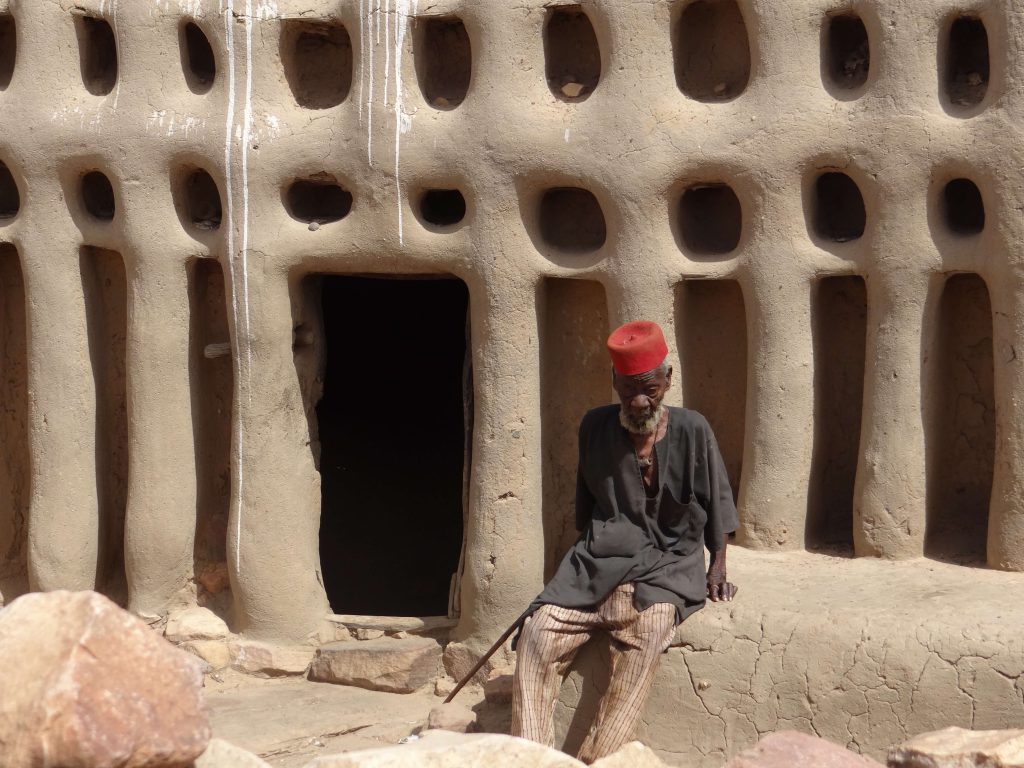
Dogon people of Mali: Part 2
Apr. 30 | 2018
Dogon Religion
The Dogon community’s life is centered around the Hogon, who is the spiritual leader of the village. The oldest man in the village becomes a Hogon. After his election he must follow six months imprisonment, during which he is not allowed to shave or wash. He wears white clothes and no one is allowed to touch him. His meals, prepared by impuberic girls, are brought to him in bowls called “Ogo Banya.” He receives these bowls from his predecessor or during his induction ceremony.
After his initiation, he will wear a red cap. He has an armband with a sacred shell that symbolizes his function. The Hogon must live alone in his house. The Dogon believes that the sacred snake “Lebe” comes during the night to purify him and communicate wisdom to him.
The Dogon believe in a single god called “Amma,” who created the land and had a son, Yurugu or the “pale fox.” Yurugu was an imperfect being who only knew the first word, the secret language “sigi so.” The earth then gave Amma a pair of twin children called Nommo.

Sigui Ceremony
Sigui, the highlight of Dogon life, is observed every 60 years, corresponding to the duration of life of the first Dogon ancestor. The Dogon determine the date by knotting a rope every five days, which allows them to celebrate the Sigui with precision. These five days make up the Dogon week. The Sigui is celebrated over seven years, during which time the Great Mask is carved from a single piece of wood, measuring several metres in length.
From 1967-74, French filmmaker and anthropologist Jean Rouch created a series of films that documented the Sigui. According to Rouch, the dates of the last Sigui were 1787, 1847, 1907 and 1967. The next Sigui will likely take place in 2027. Sigui is rarely observed by most of young Dogon because of time conflict in modern life.
https://youtu.be/oNd9E3gBTok
The Divinatory Table
In life management, the Dogon consult the “Divinatory Table” which serves as an instrument of divination to predict the future for the Dogon.
The divination ceremony begins just before sundown in the evening. The “diviner” or priest begins the ritual by drawing six interconnected squares in the sands at the foothills of the Bandiagara Cliffs. Together with the squares, an intricate pattern of symbol is drawn that represent God’s wishes, life and death, regional harmony and peace, and future of the families and the village.
Subsequently, ‘l’ shaped drawings representing peace and death are traced. Then, the priest places tiny sticks representing God and family in the sand panels. Thereafter minutely holed small sand mounds representing next harvest, village harmony, sickness and individual mortality are made.
All along while drawing sand patterns, the priest chants prayers appealing to the fox to come and foretell the future. The prayers finish just before darkness and everyone returns to the village.
The following morning, all villagers gather at the site of the ceremony to discover footprints of the fox across the sand drawings made by the diviner. The path of the fox foretells the future of the village for the forthcoming year.
https://youtu.be/XLO8iVJ0nTQ
This is part two of a four-part blog series on the Dogon People of Mali, West Africa.
• Read Part 1
• Read Part 3

